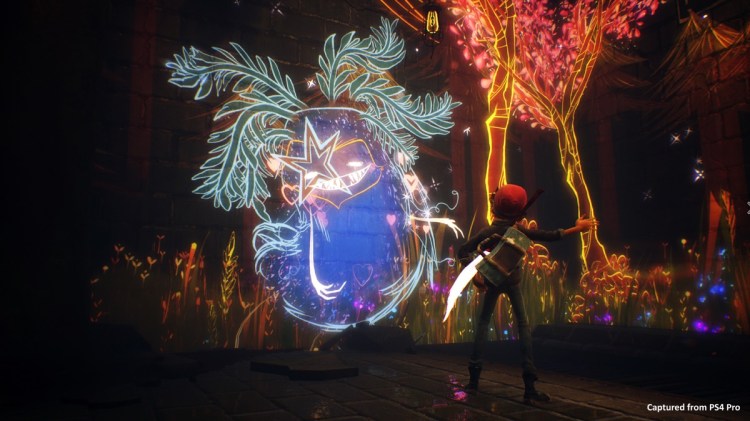Concrete Genie is a kind of psychological journey, played out on the canvas of a video game. A young artist named Ash escapes his troubles by painting spectacular living landscapes in his abandoned hometown of Denska.
But the neighborhood bullies menace him and ruin his work. Ash’s internal drama is externalized as he fights to restore color to the drab world of Denska.
This heartwarming parable comes from an unlikely game studio, Pixelopus, a small team that has been working for 4.5 years on the title at Sony’s studio in San Mateo, California. I played the action-adventure game, which comes out on October 8 for $30 on the PlayStation 4.
You use the motion controller to paint the world, interacting with dream-like genies who live in the concrete and wood of the walls of Denska. It is a unique art-driven video game where you can express your own creativity. You can also enjoy a virtual reality version with the PlayStation VR.
After the demo, we got a tour of Pixelopus’ offices at Sony’s U.S. game headquarters in San Mateo, California. I interviewed Pixelopus creative director Dominic Robillard and art director Jeff Sangalli about the making of the game. They told me that the idea was born in their art department, from a visual effects artist named Ashwin Kumar. They were tossing around ideas after they shipped Entwined, and they came up with this concept of a young boy artist being bullied. And Sony liked it so much that they let the team run with it, and now here we are.
Here’s an edited transcript of our interview.
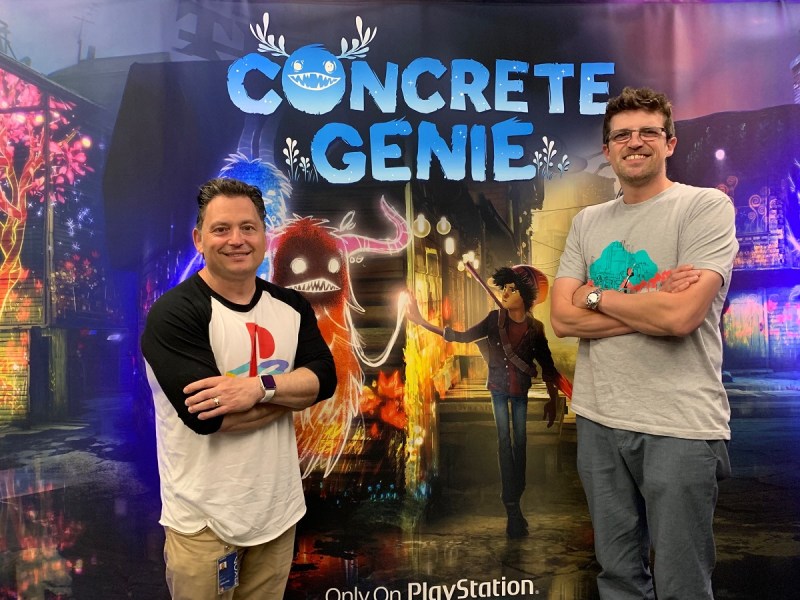
Above: Concrete Genie creators Jeff Sangalli, art director, (left) and Dominic Robillard, creative director.
GamesBeat: How long have you been working on this now?
Dominic Robillard: We started the very first concept in the beginning of 2015, so four and a half years. Just over four and a half years by the time it comes out.
GamesBeat: Is the VR element part of your work, or is that another team?
Robillard: That’s a different team. We invited some friends of ours to come in a couple of years ago and look at the game. We had wanted to do VR, but at the time we had to make that decision, there were only 12 people on the team. It was too much for us to take on along with everything else that’s in the game. We showed these friends of ours, Jeff and Dave, the game, and they had this awesome pitch for what they would do if they had a chance to work on a VR version. What if I could paint and then step into the painting and go into the world of the genies and paint in 3D all around me in VR?
We loved that so much that we actually managed to hire them and built a small team around them. They’re just around the corner from the studio. They’ve been working on that for about two years now.
GamesBeat: I saw that first last time, the VR version. It looked very different from this more story-based adventure.
Robillard: It’s funny. When you have to describe all the painting in the VR version, it gets a bit confusing. But when you’re painting on the walls in VR, that’s all our tech. As we’ve been building the brushes in the main game, that’s piped through, because we all use Unreal and we share all the tools and the tech. That’s all the same. Also, in the free painting, as you get all the free paint locations in VR, all the brushes you find in the main game are the ones you can use in the VR free paint. It’s connected like that. But stepping into your painting and into the genie world, that’s all the new parts they’ve built, all those 3D VR brushes.
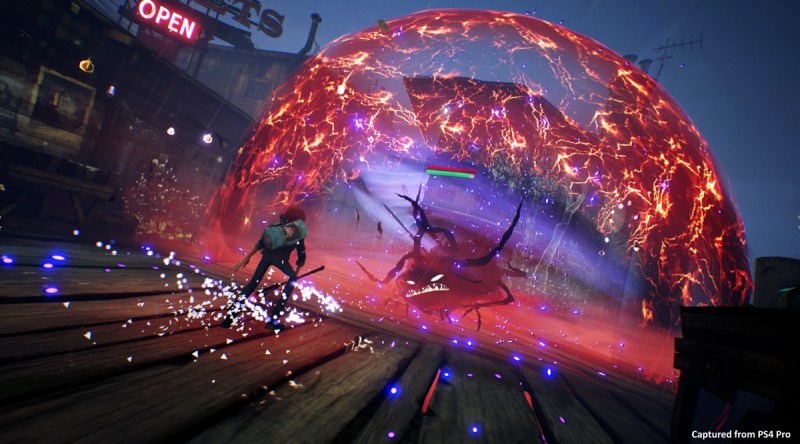
Above: Ash has to deal with the negativity in the town of Denska.
GamesBeat: Are the environments very different than the town you’re in, or where you’re out in the fields?
Robillard: When you’re in the world of the genies? That’s when you’re in their work. If you remember, where you start the VR version, it’s the lighthouse. In the bit you just played, where you picked up the brush, that’s the location where the VR begins. Then you step into their world, essentially. That’s why it looks so different.
GamesBeat: Where did the original idea come from? It seems like the kind of pitch that you couldn’t communicate to somebody in words.
Robillard: You’re on the money. It literally didn’t begin as a traditional pitch. When we finished Entwined, we had a moment to spend some time concepting what we wanted to do next as a team. One of our favorite things about working in small teams is you can have a completely flat hierarchy. We had a chance to say to everyone on the team, “Everyone come up with game ideas for what we want to do next.”
The original idea for Concrete Genie came from Ashwin Kumar, who’s our VFX artist. That’s why he’s called Ash in the game. The first thing he did to communicate this idea was painting a picture of a small boy being bullied and painting these huge characters in a wall. He was imagining that they were sticking up for him. That was the very first beginning. It wasn’t a written document or anything. It was just that picture. This concept — the bullying and the idea of an artist using art to cope with some of the things happening to him — was there from the first moment.
GamesBeat: What influenced how it came to look and play?
Jeff Sangalli: After Ash generated that first piece of artwork, the whole art department started to build imagery around that concept. At the same time we had decided that we would use Unreal as our game engine. We started to use more complex lighting in our concept art, trying to come up with a style that would be more dramatic lighting-wise and have, hopefully, a better emotional connection because of that.
Then we started thinking about — we were all inspired by the lighting in stop motion. We wanted the world to feel handcrafted. We tried to break down what we were responding to about stop motion. That was another big inspiration for the 3D world. That inspired some of the stuff you had a chance to see today: the keyframe animation, the face illustrations. The 2D world was really inspired by children’s book illustration, and by urban artwork as well.
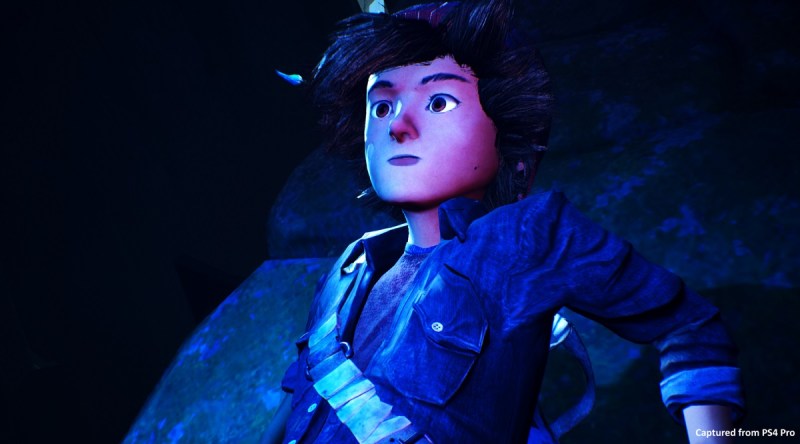
Above: Ash’s face is hand-drawn on a flat piece of paper, and then wrapped around a 3D object.
GamesBeat: Cleaning up the city, is that something like Flower, or other games that are out there?
Robillard: We love all of those games. The other thing that was connected to that, there was an environmental theme in some of the other concepts that we’d developed when we were looking at doing Concrete Genie originally. It was the moment when Jeff and I realized that that group, that team, has a natural instinct for expressing ideas that have a heart or a message or a meaning to them. Every single — we came up with seven or eight different game ideas, and Concrete Genie was one. But all of them had that in there, which was really interesting, that there was this intuition for that from this group of kids. Or I shouldn’t call them kids anymore.
GamesBeat: You mentioned you have a pretty young team, though.
Robillard: Yeah, yeah. Most of that team, this is their first job in the game industry. But there was an environmental theme in one of the other ideas. When we were developing the painting mechanics, of which we did several iterations — the version you just played is the third version of the painting mechanics.
GamesBeat: With the motion controls, being the center of it?
Robillard: That was a part of it. The other versions were interesting, but they didn’t go far enough in terms of expression. We had some basic versions of stenciling. There were ones where you threw paint splats on the wall. But it wasn’t until we did this version where you could much more carefully author exactly what you wanted and grow that into something beautiful that we made that connection for players, to feel connected to their artwork.
The other thing that came with that was the ability to paint anywhere. That only came in the last version. This idea that suddenly everyone’s version of the town would be unique and different was where we started connecting it to an environmental aspect as well. Using that ability to paint everywhere and bring some of it back to life came from that. It was a natural fit for the story and the level progression in the game.
GamesBeat: Painting is, by itself, fun for some people. But how to you make painting fun all the time in a game like this?
Robillard: Nobody’s phrased it like that, but that’s exactly what we’re trying to do, make it fun all the time for everyone. From the moment that we wanted to try to have art as a mechanic, the idea that we would try to make anybody feel like they could be an artist has definitely been our central gameplay fantasy. In terms of how it’s meant to feel, we just knew that if we could use the motion controllers to let anyone make marks and gestures in the wall, and then just get the amount of assistance that the game gives, just the right amount so that it doesn’t feel like it’s doing too much — if you do that, it doesn’t feel like your artwork anymore.
Getting that balance from the gameplay, agency versus assistance, getting it in just the right place, and then having a lot of sophisticated stuff under the hood that layers everything correctly for you, or tries to connect the elements you’re painting together — we draw ground around the things that need ground. There’s a lot of light touches in there that help compose the image for you, but never change it or add too much so you feel like it’s not your artwork.
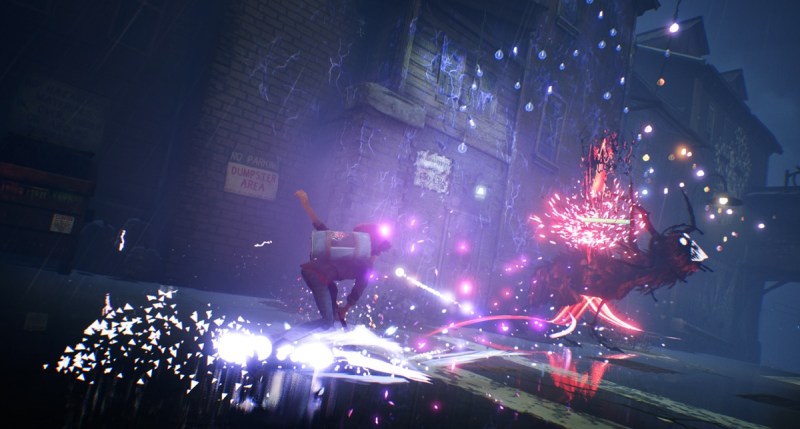
Above: Concrete Genie has spectacular art.
GamesBeat: It’s hard to mess up your art. It reminds of Spider-Man that way, where it was hard to mess up swinging around.
Sangalli: We wanted to make sure you didn’t feel like you were being penalized for painting the way you want to paint. We’ve seen some kids that just want to paint rainbows all over the entire city. It looks really beautiful, actually. Who are we to judge their paintings?
Robillard: The game never judges you. That’s why we have the light strands, because that’s just to say, “We want you to paint here.” We don’t tell you what to paint or how to paint. We never judge it as good or bad.
Sangalli: We spent a lot of time tuning the city as a palette, so that the paintings really look dynamic. The glow we spent quite a bit of time on, to make sure that they feel like they’re really an allegory for Ash’s imagination. They should be as dynamic as what he would see through his own eyes.
GamesBeat: At some point, I don’t know which act, all of this switches into something ugly and dark. You kind of start with something ugly in the beginning, but you get to darker creatures and stuff like that. Why did you want to make that kind of transition.
Robillard: That transition, that twist at the end, was there from the very first prototype we ever did for this game, all those years ago. We’ve been working on it ever since then. I think what happened when we decided that we were going to try and tackle bullying as a theme — we researched it, and we knew we wanted the finale, the climax of the gameplay and the narrative, to be focused on the darkness, that negativity itself. We wanted a way to synthesize and personify the emotion as a thing that you could tackle and deal with.
We always wanted to get that in there as a way of tackling the negativity, and not about the kids. One thing you’ll see when the game comes out is we do show the backstories of those kids as well, to try to explain some of the reasons why they’ve turned into the kids that they’ve become. That twist is really about keeping it focused on the darkness itself.
GamesBeat: It reminds me of Sea of Solitude, if you’ve seen that.
Robillard: We’ve been following that, but it was released while we were in Europe last week. I can’t wait to play it.
GamesBeat: It’s a unique name. How did you come up with that?
Robillard: It was there from the beginning as well. Originally it was a working title, but we fell in love with it. It does still describe one of the key things in the game, which is the moment when Ash touches the walls and the genies come to life. That was where that came from. It just seemed like — it’s catchy, and we liked it. We became very attached to it.
